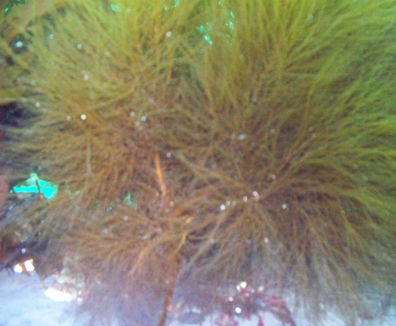
Acid Alga
BIOCHEMISTRY
Mesuare of pH of Desmarestia viridis (Picture by Kirsten Williams)
Diference of color for disecation the part green usually is more acid (Picture by Noemi Ramirez)
|
|
Biochemistry The acid concentration of D. viridis ranges 0.2 to 0.4 N which is comparable to other organisms such as tunicates or gastropods (0.1 and 0.5 N respectively) and is remarkably high for an alga. Unlike invertebrates, the acid accumulation in D. viridis occurs within the cells and is not sensitive to environmental changes or amount of growth (McClintock et al, 1982). The use of sulfate as the counterion to H+ in Desmarestia is of interest because, in general, marine algae exclude sulfate as compared with freshwater algae or higher plants (Blinks, 1951).
Acid accumulation The accumulation of both H+ and SO42- appears to be active with strong electrochemical gradients for both ions (McClintock et al, 1982). The energy source that permits these cells to generate pH across its membranes is the H+ uptake into the vacuole, which is driven by a tonoplast ATPase. It must have a stoichiometry of not more than 1H+ transported per ATP hydrolyzed in order to provide sufficient energy to generate such a large proton gradient (Reenestra, 1981), assuming that the cytoplasmatic pH is close to 7 and the plasma membrane transmembrane potential is not too different from the vacuole-outside membrane potential. (McClintock et al,1982). Once accumulated, the ions are largely trapped within the vacuole, the concentration of H+ is unaffected by variations in the light-dark regime and is constant throughout the growing season (McClintock et al, 1982). The equivalence of accumulated H+ and SO42- suggests that these ions may be cotransported. Sulfate uptake into yeast is believed to involve a cotransport of one SO42- with 3 H+ (Roomans, 1979). How do these cells withstand such a low pH? Literature Cited:
Reentra, W. W, J.G. Forti, 1981. H+ ATP stoichiometry for the gastric (K+ + H+) ATPase. J. member Biol 61:55-60.
Stoichiometry: Word derived from Greek that means Stoikheio = element and metron = measure. it is the calculation of quantitative relationship of the reactants and products in a balanced chemical reaction. Tonoplast: A cytoplasmic membrane surrounding the vacuole, these separate the vacuolar contens from the cytoplasm in the cell
Website created by: Noemi Ramirez ramirezmiss1@gmail.com ZooBot Spring Quarter 2009 Friday Harbor Laboratories University of Washington |
